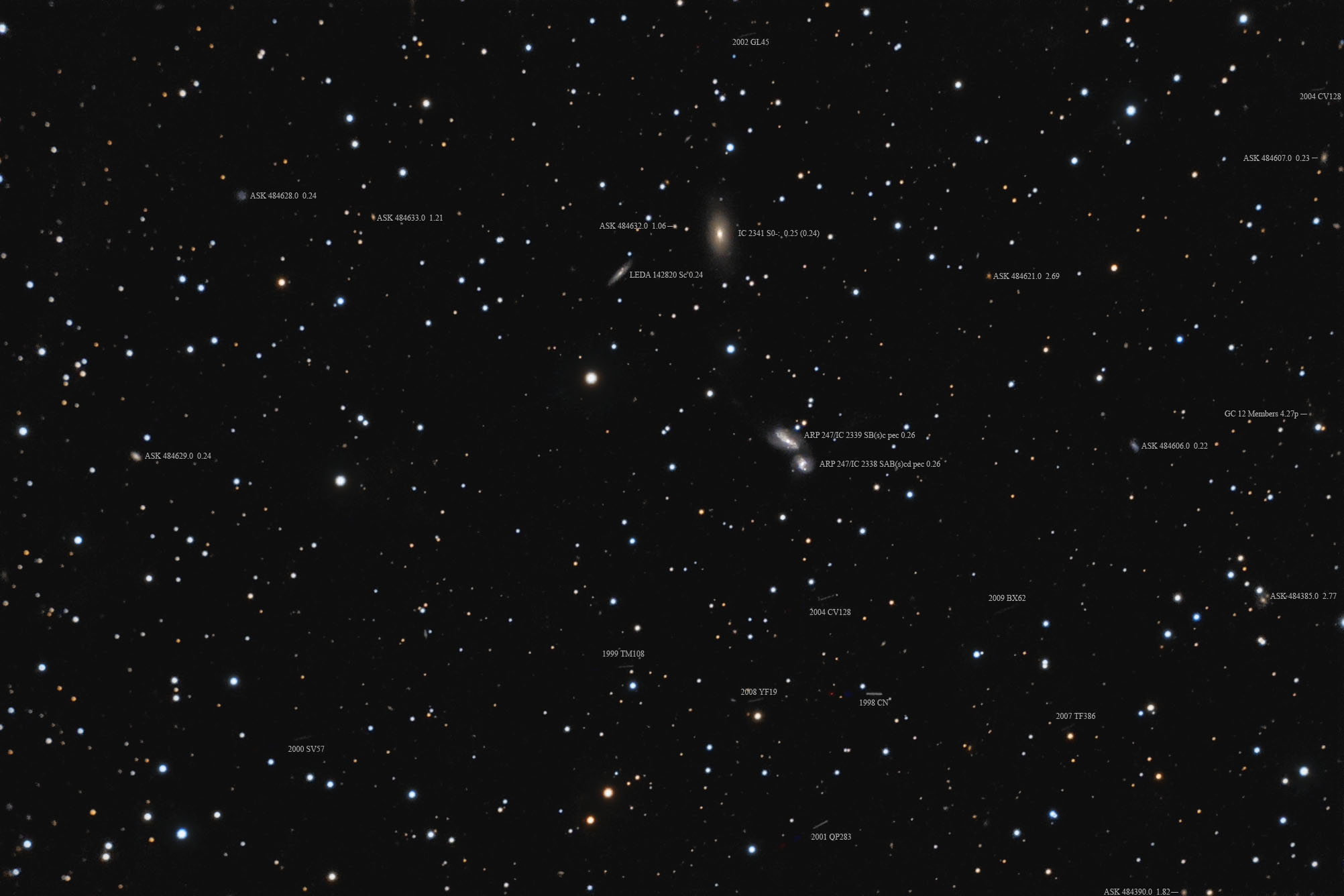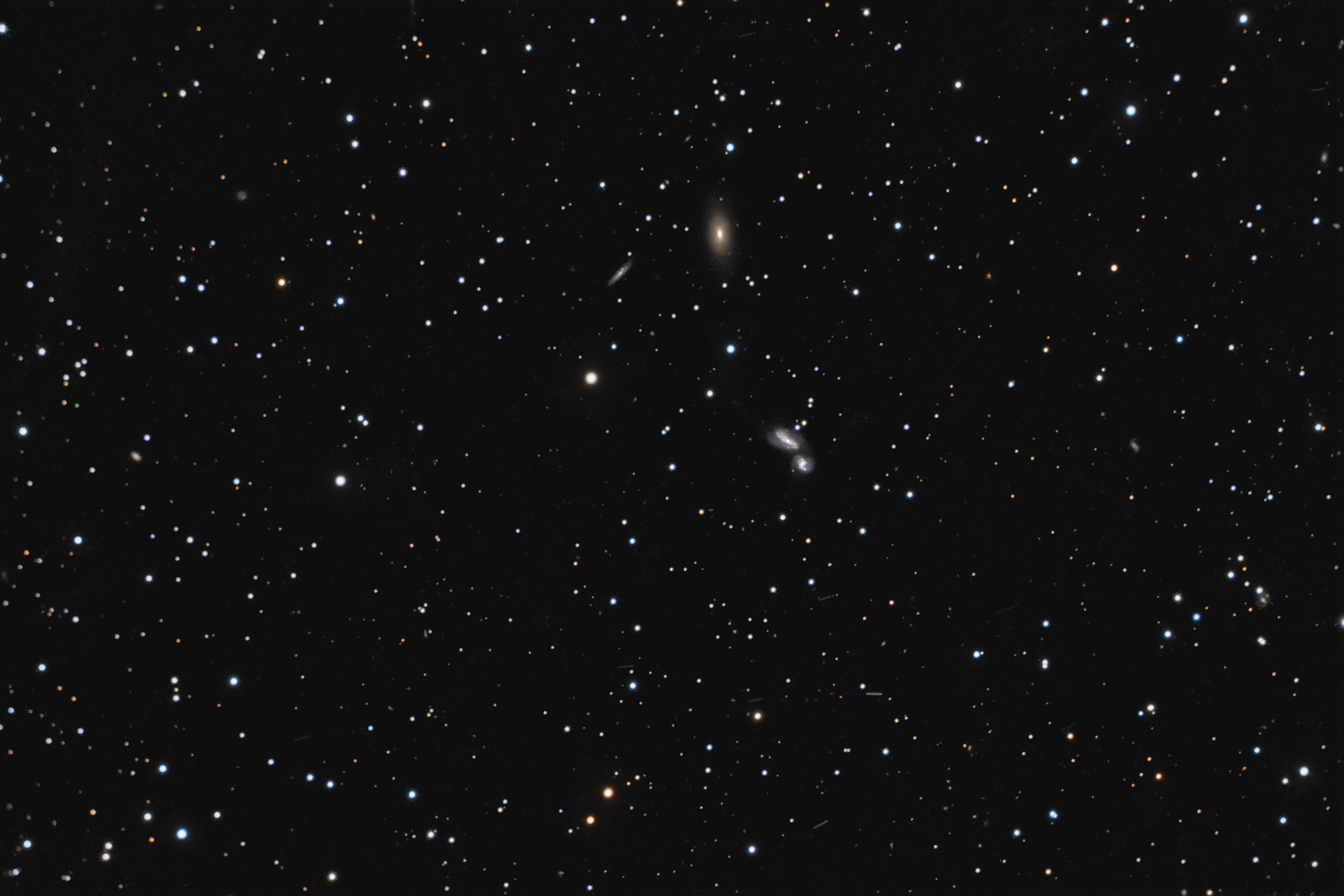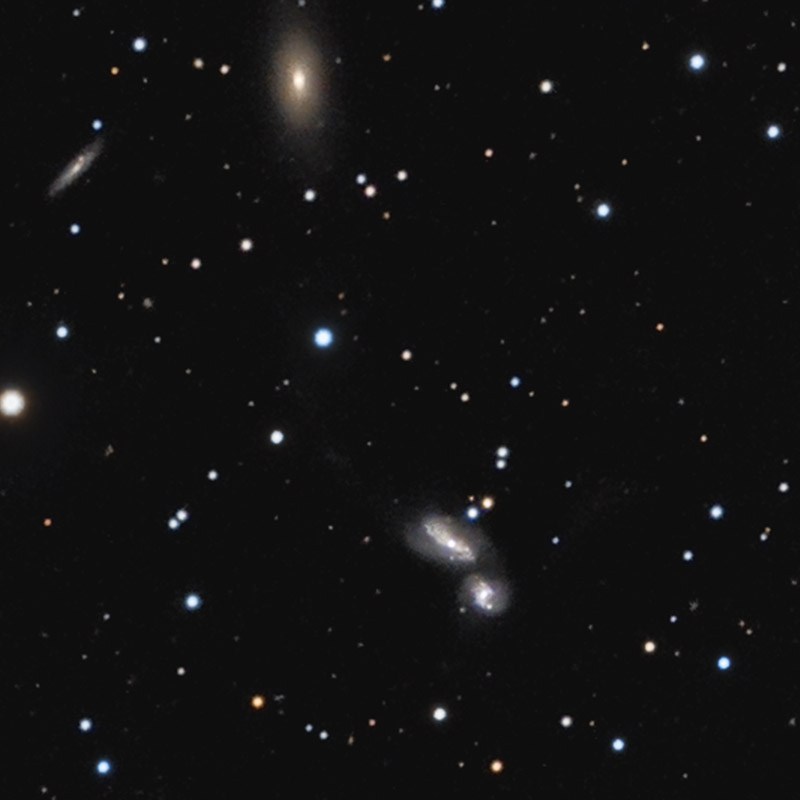| Description | Images |
Object name: ARP247Designation(s): ARP247, IC2338, IC2339, IC2341, Arp 247 is a pair of interacting galaxies; IC 2339 and IC 2338, left to right and top to bottom. A common arm connects them. At least Arp seems to say this when he says: "Spirals have common arm, N spiral arm continues NE." The latter comment seems to refer to the southern arm of IC 2339 that goes north and continues as a faint tidal streamer far beyond the galaxy. He seems to have missed a similar streamer going mostly west and a bit north on the other side. It is fainter and out of his image. Apparently, he didn't know it was there. It is classed under his category: Galaxies (not classifiable as S or E); Appearance of fission. Odd but his comment calls them spirals then he puts them in a class saying they aren't identifiable as spiral or elliptical. I see several problems here. One is that while the arm may appear "common" to both galaxies this is possibly a perspective issue and if seen at a different angle one is likely in front of the other and we are seeing an overlapping of two separate arms. Since colliding galaxies can merge but not split as they are already separate objects this might be fusion (a merger in progress) but certainly not fission. Or is he referring to that tidal arm as splitting off? We now know these almost always collapse back into the merging galaxies though some stars may never return, most do. At least in the simulations I've seen or run. Related Designation(s):2MASS J08233266+2120173, 2MASS J08233422+2120514, 2MASS J08234143+2126054, 2MASX J08233267+2120174, 2MASX J08233424+2120514, 2MASX J08234141+2126048, 2MASXi J0823326+212017, 2MASXi J0823342+212051, 2MASXi J0823414+212604, ARP 247, ARP 247 NED01, ARP 247 NED02, ARP247, ASK 484618.0, ASK 484634.0, Cancer Cluster:[SD87a] 162, Cancer Cluster:[SD87a] 165, CGCG 0820.7+2130, CGCG 0820.7+2130 NED01, CGCG 0820.7+2130 NED02, CGCG 0820.8+2136, CGCG 119-080, CGCG 119-080 NED01, CGCG 119-080 NED02, CGCG 119-080E, CGCG 119-080N, CGCG 119-080S, CGCG 119-080W, CGCG 119-081, CXO J082332.6+212017, CXO J082334.1+212050, CXO J082341.4+212605, GALEXASC J082332.63+212017.2 , GALEXASC J082334.30+212052.5 , GALEXASC J082341.41+212604.9 , HDCE 0480 NED011, IC 2338, IC 2339, IC 2341, IC2338, IC2339, IC2341, IRAS 08206+2130, IRAS F08206+2130, KPAIR J0823+2120 NED01, KPAIR J0823+2120 NED02, KPG 161, KPG 161A, KPG 161B, LDCE 0571 NED013, MCG +04-20-044, MCG +04-20-045, MCG +04-20-046, NGC 2563:[ZM98] 0007, NGC 2563:[ZM98] 0012, NGC 2563:[ZM98] 0020, NSA 084237, NSA 084243, NSA 135062, PGC 023542, PGC 023546, PGC 023552, SDSS J082332.66+212017.1, SDSS J082332.67+212017.1, SDSS J082334.21+212051.4, SDSS J082334.21+212051.5, SDSS J082341.44+212605.5, SDSS J082341.45+212605.6, SSTSL2 J082332.63+212016.7, SSTSL2 J082334.19+212050.9, SSTSL2 J082341.44+212605.5, UGC 04383, UGC 04383 NED01, UGC 04383 NED02, UGC 04384, USGC U173 NED02, USGC U173 NED04, USGC U173 NED05, UZC J082332.7+212016, UZC J082334.3+212052, UZC J082341.4+212605, [CSD91] Cb13, [CSD91] Cb14, [CSD91] Cf21, [TTL2012] 366995, [TTL2012] 367799, | Permanent link: https://images.mantrapskies.com/catalog/ARP-GALAXIES/ARP247-IC2338-IC2339-IC2341/ARP247L4X10RGB2X10X3RMERGE-ID.JPG |


